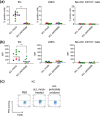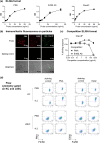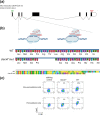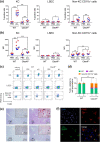Mucins Shed from the Laminated Layer in Cystic Echinococcosis Are Captured by Kupffer Cells via the Lectin Receptor Clec4F
- PMID: 37162364
- PMCID: PMC10269144
- DOI: 10.1128/iai.00031-23
Mucins Shed from the Laminated Layer in Cystic Echinococcosis Are Captured by Kupffer Cells via the Lectin Receptor Clec4F
Erratum in
-
Correction for Barrios et al., "Mucins Shed from the Laminated Layer in Cystic Echinococcosis are Captured by Kupffer Cells via the Lectin Receptor Clec4F".Infect Immun. 2023 Nov 16;91(11):e0029923. doi: 10.1128/iai.00299-23. Epub 2023 Oct 17. Infect Immun. 2023. PMID: 37847030 Free PMC article. No abstract available.
Abstract
Cystic echinococcosis is caused by the larval stages (hydatids) of cestode parasites belonging to the species cluster Echinococcus granulosus sensu lato, with E. granulosus sensu stricto being the main infecting species. Hydatids are bladderlike structures that attain large sizes within various internal organs of livestock ungulates and humans. Hydatids are protected by the massive acellular laminated layer (LL), composed mainly of mucins. Parasite growth requires LL turnover, and abundant LL-derived particles are found at infection sites in infected humans, raising the question of how LL materials are dealt with by the hosts. In this article, we show that E. granulosus sensu stricto LL mucins injected into mice are taken up by Kupffer cells, the liver macrophages exposed to the vascular space. This uptake is largely dependent on the intact mucin glycans and on Clec4F, a C-type lectin receptor which, in rodents, is selectively expressed in Kupffer cells. This uptake mechanism operates on mucins injected both in soluble form intravenously (i.v.) and in particulate form intraperitoneally (i.p.). In mice harboring intraperitoneal infections by the same species, LL mucins were found essentially only at the infection site and in the liver, where they were taken up by Kupffer cells via Clec4F. Therefore, shed LL materials circulate in the host, and Kupffer cells can act as a sink for these materials, even when the parasite grows in sites other than the liver.
Keywords: Clec4F; Echinococcus; Kupffer cells; laminated layer; lectin; mucin.
Conflict of interest statement
The authors declare no conflict of interest.
Figures







Similar articles
-
Immunology of a unique biological structure: the Echinococcus laminated layer.Protein Cell. 2023 Mar 16;14(2):87-104. doi: 10.1093/procel/pwac023. Protein Cell. 2023. PMID: 36929004 Free PMC article.
-
The surface carbohydrates of the Echinococcus granulosus larva interact selectively with the rodent Kupffer cell receptor.Mol Biochem Parasitol. 2013 Nov-Dec;192(1-2):55-9. doi: 10.1016/j.molbiopara.2013.12.001. Epub 2013 Dec 17. Mol Biochem Parasitol. 2013. PMID: 24361107
-
Studies on the structural mucins of the Echinococcus granulosus laminated layer.Mol Biochem Parasitol. 2010 Dec;174(2):132-6. doi: 10.1016/j.molbiopara.2010.07.008. Epub 2010 Aug 6. Mol Biochem Parasitol. 2010. PMID: 20692297
-
The laminated layer: Recent advances and insights into Echinococcus biology and evolution.Exp Parasitol. 2015 Nov;158:23-30. doi: 10.1016/j.exppara.2015.03.019. Epub 2015 Mar 25. Exp Parasitol. 2015. PMID: 25816974 Review.
-
Echinococcus granulosus sensu lato genotypes infecting humans--review of current knowledge.Int J Parasitol. 2014 Jan;44(1):9-18. doi: 10.1016/j.ijpara.2013.08.008. Epub 2013 Nov 19. Int J Parasitol. 2014. PMID: 24269720 Review.
Cited by
-
Hydatid fluid from Echinococcus granulosus induces autophagy in dendritic cells and promotes polyfunctional T-cell responses.Front Cell Infect Microbiol. 2024 May 16;14:1334211. doi: 10.3389/fcimb.2024.1334211. eCollection 2024. Front Cell Infect Microbiol. 2024. PMID: 38817444 Free PMC article.
-
Ontogeny, functions and reprogramming of Kupffer cells upon infectious disease.Front Immunol. 2023 Aug 25;14:1238452. doi: 10.3389/fimmu.2023.1238452. eCollection 2023. Front Immunol. 2023. PMID: 37691953 Free PMC article. Review.
-
Tissue macrophages: origin, heterogenity, biological functions, diseases and therapeutic targets.Signal Transduct Target Ther. 2025 Mar 7;10(1):93. doi: 10.1038/s41392-025-02124-y. Signal Transduct Target Ther. 2025. PMID: 40055311 Free PMC article. Review.
-
Characterization of the immunosuppressive environment induced by larval Echinococcus granulosus during chronic experimental infection.Infect Immun. 2024 Feb 13;92(2):e0027623. doi: 10.1128/iai.00276-23. Epub 2024 Jan 4. Infect Immun. 2024. PMID: 38174942 Free PMC article.
References
-
- Cucher MA, Macchiaroli N, Baldi G, Camicia F, Prada L, Maldonado L, Avila HG, Fox A, Gutiérrez A, Negro P, López R, Jensen O, Rosenzvit M, Kamenetzky L. 2016. Cystic echinococcosis in South America: systematic review of species and genotypes of Echinococcus granulosus sensu lato in humans and natural domestic hosts. Trop Med Int Health 21:166–175. doi:10.1111/tmi.12647. - DOI - PubMed
Publication types
MeSH terms
Substances
Grants and funding
LinkOut - more resources
Full Text Sources
Miscellaneous

